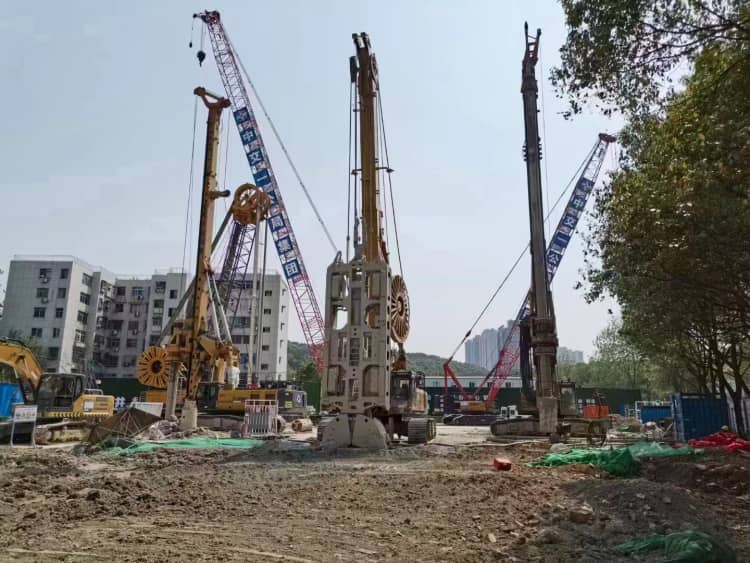Why Is Cleaning Bored Piles Necessary?
Cleaning bored piles (also known as cleaning the borehole) is a crucial step in pile foundation construction. If the sediment at the bottom of the hole is too thick, underwater concrete pouring can lead to interlayers, broken piles, or even complete failure of the pile. Therefore, proper cleaning is essential to ensure structural integrity.
Before pouring concrete, the hole depth should be rechecked using a measuring rope. If sediment thickness exceeds allowable limits, debris removal methods such as a slag removal bucket or slurry pump should be used. For minor sediment buildup, water jet cleaning (as described below) can be effective.
Key Steps in Cleaning Bored Piles
1. Initial Cleaning After Drilling
- Once drilling reaches the design depth, inspect the hole for diameter, depth, position, and verticality.
- Cleaning must begin immediately after confirming the hole meets specifications.
- Sediment thickness before concrete pouring must comply with design and regulatory standards.
2. Cleaning Standards
- The discharged slurry should have no particles larger than 2–3 mm when touched.
- Slurry density should not exceed 1.1 g/cm³.
- Sand content should be less than 2%.
- Viscosity should be 17–20 seconds.
- Important: Never replace proper cleaning with simply deepening the borehole.
3. Post-Cleaning Procedures
- After cleaning, install the reinforcement cage and proceed with underwater concrete pouring.
- Before pouring, use water or air jets (0.05 MPa pressure) to agitate sediment at the hole bottom for 3–5 minutes, ensuring suspended particles are removed.
FAQs About Cleaning Bored Piles
1. Why Is Cleaning Necessary for End-Bearing Piles?
End-bearing piles transfer structural loads primarily through the pile tip. Since sediment is loose and lacks load-bearing capacity, excessive buildup can cause unacceptable settlement. Cleaning ensures the pile meets design requirements.
2. What Are the Cleaning Standards for Bored Piles?
Before pouring concrete:
- Sediment thickness: ≤10 cm (for slurry drilling).
- Slurry properties:
- Density: 1.1–1.2 g/cm³.
- Viscosity: 17–20 seconds.
- Sand content: <2%.
Water/air jets help suspend sediment, reducing buildup.
3. Primary vs. Secondary Cleaning Methods
- Primary Cleaning: After drilling, slightly raise the drill pipe to stir sediment, removing debris via positive circulation.
- Secondary Cleaning: After removing the drill, installing the reinforcement cage, and placing the conduit, use pump suction reverse circulation for final cleaning.
4. How to Handle Hole Collapse During Cleaning?
In sandy soils, slurry flow can cause collapses. A proven solution:
- Mix cement and salt (2:1 or 2:2 ratio).
- Example: 2 bags of cement + 1 bag of salt.
- Pour mixture into the hole (it will sink due to higher density).
- Wait no more than 7–8 hours before redrilling.
- Use high-quality commercial concrete with proper slump for pouring.
5. Why Is Secondary Cleaning Needed for Slurry-Wall Piles?
- Conducted after placing the reinforcement cage and conduit.
- Removes debris dislodged during cage installation.
- Adjusts slurry density before concrete pouring.
- Permissible sediment thickness:
- End-bearing piles: ≤100 mm.
- Friction piles: ≤300 mm.
- Tension piles (anti-uplift): ≤150 mm.
6. What Is Slurry Wall Protection?
Slurry wall protection uses a mixture of water, bentonite, and additives (like CMC) to stabilize boreholes. Benefits include:
- Preventing wall collapse via hydrostatic pressure and filter cake formation.
- Carrying away drill cuttings.
- Cooling and lubricating drilling tools.
After excavation, concrete replaces the slurry, forming a solid underground wall.
Conclusion
Proper cleaning of bored piles ensures structural stability and prevents defects like interlayers or broken piles. Following standardized cleaning methods—including primary and secondary cleaning—guarantees compliance with engineering requirements. For challenging conditions (e.g., collapses), solutions like cement-salt mixtures can effectively restore borehole integrity.
By adhering to these practices, construction teams can achieve durable, high-quality pile foundations that meet safety and performance standards.

